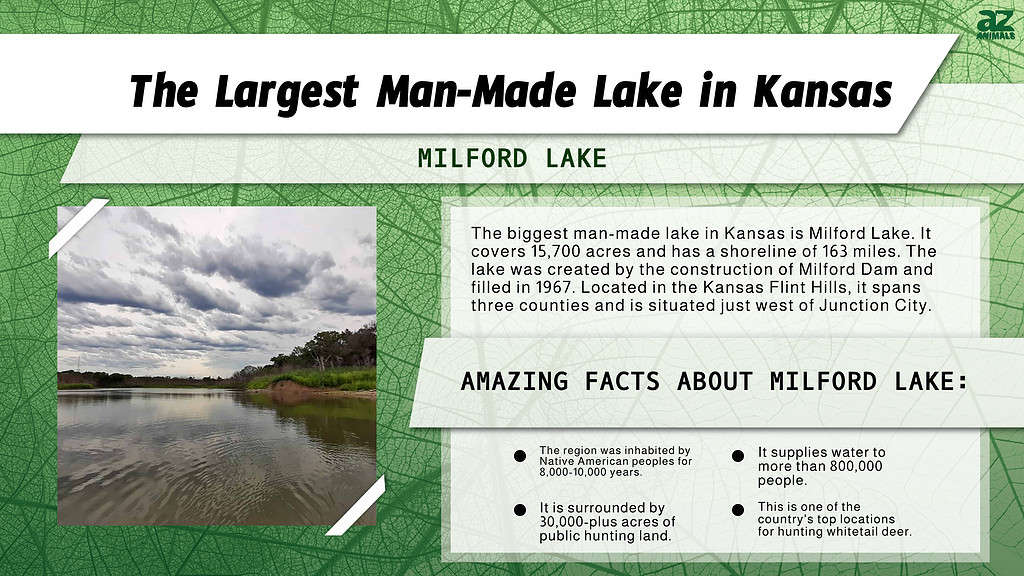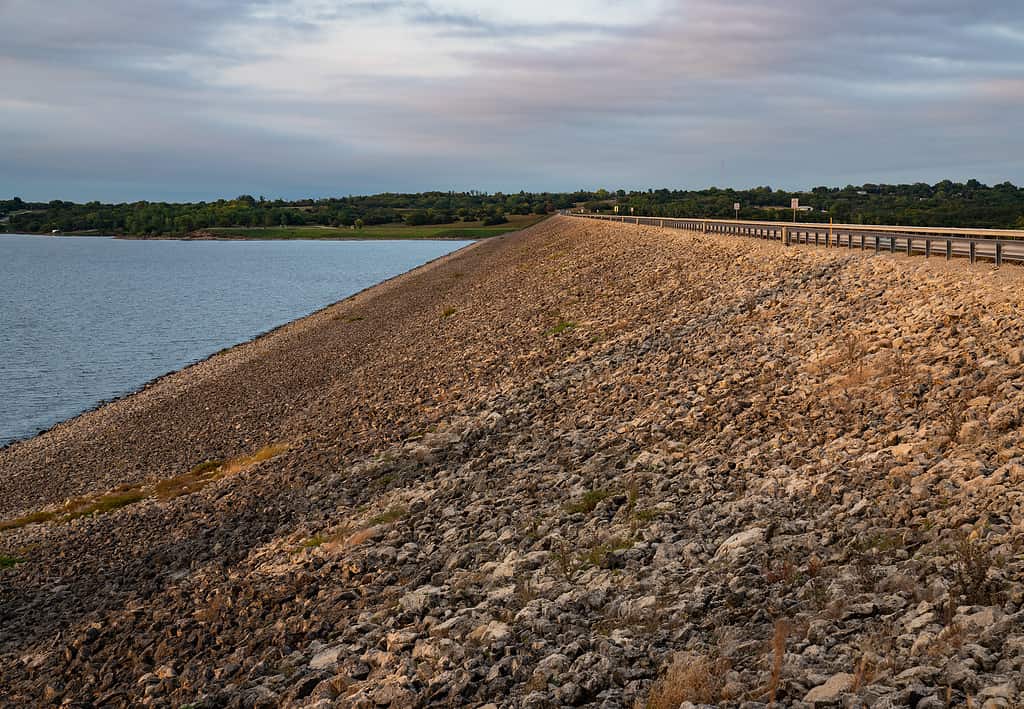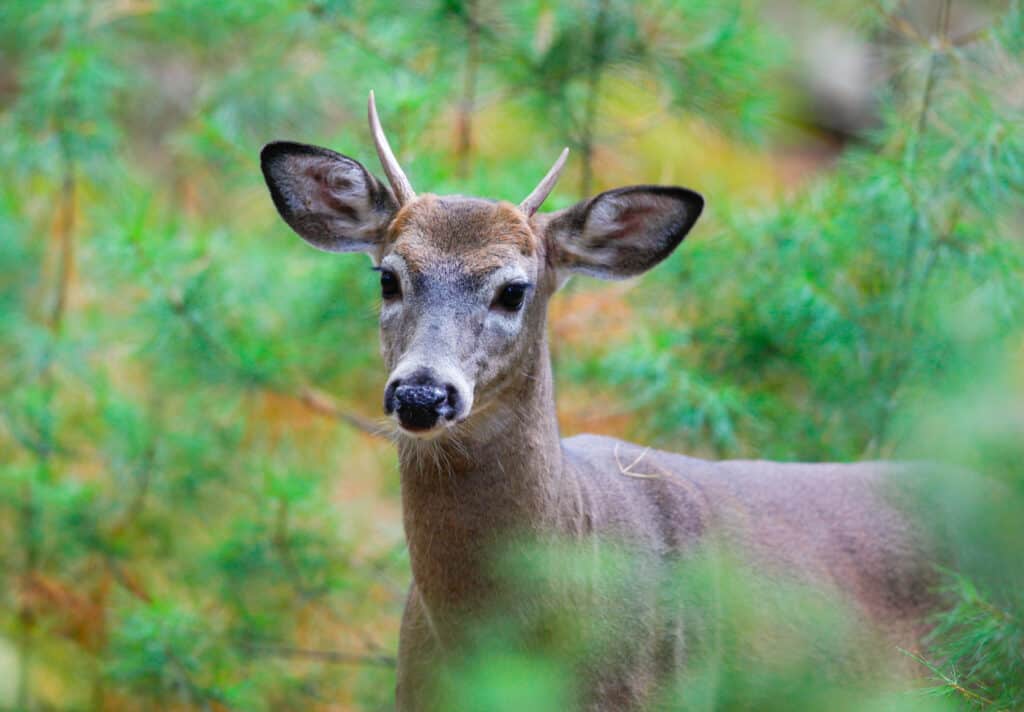Key Points:
- Milford Lake is the largest man-made lake in Kansas, covering more than 15,700 acres with a shoreline of 163 miles.
- Part of the reason that Milford Lake was constructed was because of the massive flooding that used to happen in the area each year. After the government was asked to intervene, the Milford Damn and reservoir were created to solve the problem.
- There are more than 30,000 acres of public hunting land surrounding the lake, making it one of the best spots in the state for hunters, fishermen, and outdoor enthusiasts.
Kansas relies on certain water systems to support the massive agricultural industry within the state, and reservoirs and man-made lakes are an important part of that system. In fact, the largest man-made lake in Kansas supplies water to nearly 1 million people, showing just how important it is! Today, we are going to be learning about the largest man-made lake in Kansas, including its size, depth, history, and the native wildlife of the region. Let’s get started and discover: What’s the largest man-made lake in Kansas?

The Largest Man-Made Lake in Kansas
Milford Lake is the largest man-made lake in Kansas, covering over 15,700 acres with a shoreline of 163 miles. It is a popular spot for recreational activities such as boating, fishing, and swimming, and it also offers plenty of opportunities for hunting and other outdoor adventures. In addition to its size, Milford Lake is also recognized for the huge amount of protected land the park and surrounding area incorporate. The lake and its surrounding area encompass over 33,000 acres of protected land that is open for recreational and public hunting use. This makes it a great place for anyone looking to experience the best outdoor experiences that Kansas has to offer, specifically when it comes to hunting.
Milford Lake is fed by the Republican River and collects water throughout the Milford Lake Watershed. This ensures that it is always well-stocked with fish and other aquatic life, making it a prime place for fishermen. In addition to its recreational activities, Milford Lake is also an important source of water for the surrounding area, providing a reliable source of irrigation and other important uses. More than 800,000 people rely on Milford Lake for their water.

The Milford Dam, built on the Republican River, created Milford Lake, the largest man-made lake in Kansas.
©Tony Webster from Minneapolis, Minnesota, United States / CC BY 2.0., via Wikimedia Commons – License
Where Is the Largest Man-Made Lake in Kansas?
Milford Lake is located in the heart of the Flint Hills and spans three counties in Kansas: Geary, Clay, and Dickinson. The lake is situated just west of Junction City, which is known as the “Fishing Capitol of Kansas.” This location makes Milford Lake easily accessible from a number of nearby cities and towns, and it is a popular destination for those looking to experience the natural beauty of the region.
The History of the Largest Man-Made Lake in Kansas
The history of Milford Lake dates back thousands of years, with the region being inhabited by Native American peoples for 8,000-10,000 years. During this time, the area was home to a number of different Native American cultures, including the Paleo-Indians (big game hunters), the Archaic Indians (hunter/gatherers), the Early Ceramic (Plains Woodland) people, the Middle Ceramic (village farmers), and the Late Ceramic (Kaw [Kansa]) people.
The creation of Milford Lake was authorized by the Flood Control Act of 1954 to provide a variety of benefits, including flood control, water supply, water quality, navigation, and recreation/wildlife. Construction of the Milford Dam began on July 13, 1962, at mile 8.3 of the Republican River, as a project owned and operated by the United States Army Corps of Engineers.
The region has consistently been inhabited due to its abundance of food, constant water supply, moderate climate, and diverse topography, making it a desirable place to live throughout the past few thousand years.
The Flooding of the Region
Part of the reason that Milford Lake was constructed was because of the massive flooding that used to happen in the area. Native Americans have a documented history in the area and place a huge flood dating back to 1781, with European settlers reporting floods as early as 1849. As the reports go, herds of buffalo were caught in the flood, swept downstream, and washed dead into the treetops, eventually causing a cholera outbreak in the area as the bodies rotted.
Each year after, the region flooded until the government was asked to intervene in 1951. The response was the dam that exists today, the Milford Dam, with the reservoir being filled in 1967. The dam created Milford Lake and helped to control the floodwaters that occurred each year, although the floods do still occur today.
The Wildlife of Milford Lake
Hunters travel from all over to try their hand at some game on the public hunting lands surrounding Milford Lake. The region is well-known to support a variety of animals, including pheasant, quail, prairie chickens, whitetail deer, turkey, and waterfowl. In fact, the area has been recognized as one of the top five public hunting locations for whitetail deer in the whole of the U.S.
There are over 30,000 acres of public hunting land surrounding the lake, making it one of the best spots in the state for hunters, fishermen, and outdoor enthusiasts.

The area around Milford Lake is recognized as one of the top public hunting locations for whitetail deer in the U.S.
©iStock.com/Louise Wightman
Where Is Milford Lake Located on a Map?
Milford Lake, also known as Milford Reservoir, is the largest human-made lake in Kansas, encompassing 15,700 acres of water. It manages more than 33,000 acres of land resources to offer high-quality recreational experiences while safeguarding the natural and cultural resources of the project.
Here is Milford Lake on a map:
The photo featured at the top of this post is © James St. John / Creative Commons Attribution 2.0 Generic – License / Original
Thank you for reading! Have some feedback for us? Contact the AZ Animals editorial team.






